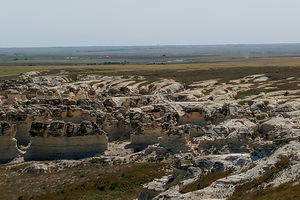
Utilized as a landmark for Native Americans and European settlers for centuries, Castle Rock itself stands 70-feet high on the otherwise gently rolling western Kansas prairie. It’s all that remains after the erosion of what was once the floor of the Western Interior Seaway from the Cretaceous Period. This particular layer of rock is known as the Niobrara Chalk: lending its name to the University of Kansas’ Rock Chalk chant. The chalk is full of fossils from the sea such as giant clams, flying reptiles, and mosasaurs. Castle rock is very fragile and will…



